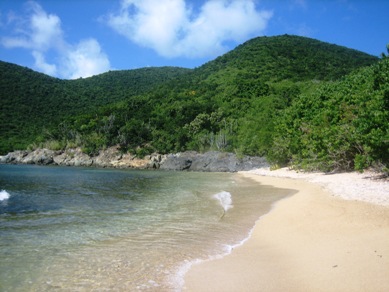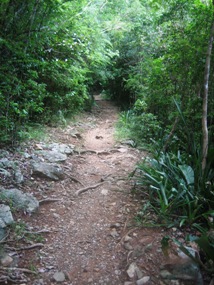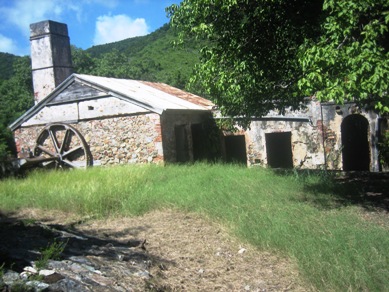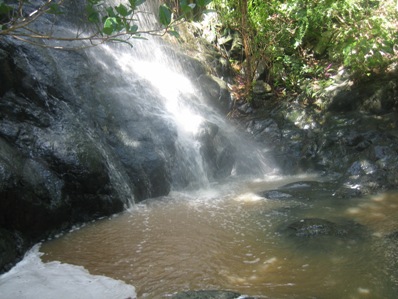
Reef Bay Trail provides nature encounters
CRUZ BAY, U.S. Virgin Islands— Standing face to face with a buck, viewing the magnificence of the plunging waterfall and observing the historical Petroglyphs were only some of the many highlights of my three-hour hike through Reef Bay Trail.
St. John’s Reef Bay Trail in the Virgin Islands National Park is a steep downhill 2.6-mile hike that leads towards Reef Bay accompanied by various historical ruins along the way.
I began my decent down Reef Bay Trail by walking down a staircase of stone steps from Centerline Road that led me into the trail. It was beautiful, completely surrounded by nothing but undisturbed nature: trees on either side leading up a hill on one side and down a steep cliff-like hill on the other.
 |
Reef Bay Trail winds its way to a secluded beach on St. John Island (Photo by Laura Funk). |
I began my hike down as I followed the clearly marked earthen pathway. Dodging various boulders that covered the path, I admired the forestry. There was an abundance of large trees that surrounded me, including genip, locust, kapok, mammee apple and mango trees.
To my right, the pathway lied on the edge of a cutoff that led down to a flowing stream below. Without anything but my own self realization, I had nothing separating me from the long way down. It was invigorating knowing I was on my own and had no limits to where I could go except the guidance of the trail.
On my way down, I came across various kinds of landmark features. Not far from the beginning of the trail, I came to the kapok or silk cotton tree. Its beauty radiated due to its semi-circular formation and magnificent height.
About a half mile down the trail, I came to the remains of the Josie Gut Sugar Estate. There I stood on the remains of the sugar cane grinding platform that was once part of an 18th century sugar plantation.
As I continued on down the trail, I encountered another significant ruin: the Par Force Village. The stone remains are all that is left of the workers village from the old sugar plantation.
After I’d been hiking for about a mile and a half, the ground began to level off, and I reached a sign on my left with an arrow leading to the cutoff trial towards the Petroglyphs. I turned down the path and began hiking down the trail. The ground was somewhat moist due to the rain that had recently poured upon the island.
| The Reef Bay Trail is a rocky and earthen path, but it offers close-up encounters with plants and wildlife (Photo by Laura Funk). |  |
I continued following the trail. It was easy to do because of the trees that outlined it. On either side of me were branches upon branches that were thick with greenery. Rays of the sun poked through the leafy dome that surrounded me and produced various shapes of light upon the dirt-covered ground.
I slowed my pace for a moment to step over a few branches that crossed the path. In doing so, I was startled by a sudden movement not too far in front of me. With a sense of surprise I quickly shift my head from worrying about the branch below my feet to the noise ahead of me. Once I look up, my heart stops when I catch eyes with a buck about 20 feet ahead of me.
I’m not sure how they are on the islands, but where I’m from in Illinois, those animals are ones to stay clear of. However, I couldn’t turn away without attempting to get at least one picture of it. With my heart pounding in my chest, I pull my camera up aiming it at the buck, attempting to keep it still from the shaking of my hands. Quickly I snap a picture. We are both still, and I can see the reflection of his eyes starring at mine.
I was unsure of what to do from this point. Eventually, I decided to turn back because I was uncertain of what he may do. After I began to walk back, about few seconds later I run into another hiker who was heading to the Petroglyphs as well. I warned him of the buck.
“Oh yeah, I saw him over there actually,” tourist Ron Herring said, pointing toward another part of the trail. “They won’t hurt you.”
With a sense of relief, I turned back around and continued on with my new friend back towards the Petroglyphs.
For most of the way, the trail was guided by an assortment of grouped pieces of stone that formed an old wall. I continued to watch my step as we sifted through the rock and stick covered dirt path when we came to a stream that made me test my balancing skills.
 |
The trail passes the ruins of the Reef Bay Sugar Mill Factory (Photo by Laura Funk). |
In an attempt to keep my sneakers dry, I carefully stepped on the various scattered rocks, not much larger than my shoes, which rested in the stream. One, two, three and from there I jumped from the last stone onto the other side of the trail. From that point, I knew we weren’t far; I could hear the waterfall that surrounded the Petroglyphs.
Up ahead, we came across some stair-step rocks and began to walk up them as we admired the sunlight that beamed through the wider openings of the trees not too far in front of us. Once we reached the top, I saw the beautiful waterfall plunging into a fresh water pool beneath it. Its natural flowing sounds fell along with it as it descended from the cliff above.
Still surrounded by trees, the sky directly above the pool and waterfall area was open providing luminance lighting that accentuated the significance and imagery of the naturalistic form.
“I’ve never seen anything like it,” Herring said. “Isn’t it beautiful?”
With a sense of amazement I simply replied, “It’s gorgeous.”
There were a cluster of large smooth rocks beside the pool that visitors were able to walk across. On the surface of the rocks lied the Petroglyphs, uniquely carved drawings and symbols. The meaning of the ancient carvings is not determined; however, they provide an exquisite visual attribute to the trail. They separated the pool from an additional cutoff in the waterfall that led to another drop behind them into a separate dark brown pool down below.
After about five minutes of soaking in the beauty around me, Herring and I head back to the main trail. After we backtracked the 0.3 miles to the entrance towards the Petroglyphs, Herring directed me towards the bay and we parted.
“Thanks for your help. It was nice to meet you,” I said.
“No problem. Good luck,” Herring replied.
All I had left was the final eight-tenths of a mile to the bay. A couple minutes down the trail, I was startled by another noise; this time it was a deer, even closer. It couldn’t have been more than five feet into the forestry beyond where I was standing on the trail.
It was an amazing experience to have the chance to be so close to wildlife and feel the rush knowing there is nothing separating me from this wild animal. I snapped a few pictures while trying not to disturb her and then continued on my way.
| Reef Bay Trail has a three-tenths of a mile cutoff trail that leads to the Petroglyphs near this waterfall. Hikers pass the waterfall if they also hike down the Petroglyphs trail (Photo by Laura Funk). |  |
I was then faced with another obstacle: the trail had flooded. The fact that the trail was level ground from this point on provided no place for the rainwater to go. The forest that surrounded me offered no place to go except through the about five inches of water. I tried to walk on the embankment, of what turned into a stream, by holding onto the trunks of the trees that guided the pathway. Only slipping a few times, I finally made it through to the end.
Before I came to the bay, I reached one more site to admire: the Reef Bay Sugar Mill Factory. The old mill has been partially restored but was once used for processing sugarcane into sugar and distilling rum through horse powered mills and steam powered engines.
After I admired the abandoned rustic stone building in its entirety, I proceeded to what I had been hiking towards. An hour and a half later, I reach my destination: Reef Bay.
The accomplishment is overwhelming knowing I just hiked the whole trail. The sunshine and cool ocean breeze was an award in itself. I stepped through the trees and onto the powdered sandy beach. I was surrounded by nature: tree-covered mountains on my right, a crystal blue ocean to my front and left and nothing but leaf-filled trees behind me. I had nothing left to do but drench my exhausted body into the refreshingly tempered water.
After I soaked in the beauty around me and cooled my body I prepared myself for my long and strenuous hike back up to the trailhead. It was one last chance to soak in the tropical scenery, pure nature smells and historic remains that consumed the trail making it an unforgettable experience.
If You Go
- A guided hike by an experienced park ranger is available Mondays and Thursdays (schedule changes during the winter months) for those who would like to avoid the uphill climb back. The hike takes approximately six hours starting from the national park’s Visitor’s Center in Cruz Bay at 9:30 a.m.
- Reservations are required and there is a transportation fee. Simply contact the National Park Service by visiting the website at http://www.nps.gov/viis or call for visitor’s information at 340-776-6201, ext. 238 or fax to 340-775-9592.
- For those who wish to hike the trail solo, transportation is provided from the Visitor Center’s bay to the head of the trail for approximately $7-$10. There is a bus that runs past the head of the trail about every hour/hour and a half that can take you back to the visitor’s center.
- The trail is open 24 hours a day year-round; however, even though the island maintains a safe environment, it is recommended to hike the trail in the morning or early afternoon.
- Hikers should bring plenty of water, wear comfortable shoes and also wear a bathing suit to take a swim at the end in the Reef Bay.

Comments are Closed